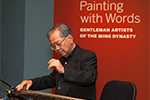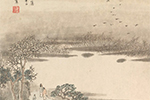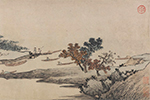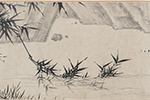
PROGRAM NOTES
Painting with Music: Bell Yung, qin
Program
Painting with Music
Bell Yung, qin
Presented at the Sackler Gallery on May 13‒15, 2016, in conjunction with the exhibition Painting with Words: Gentleman Artists of the Ming Dynasty.
| Title | Time |
|---|---|
|
Wild Geese Alighting on Level Sand (Pingsha Luoyan 平沙落雁) |
Introduction: 0:00 - 7:55 Music: 7:55 - 15:05 |
|
A Drunken Fisherman Sings in the Evening (Zuiyu Changwan 醉漁唱晚) |
Introduction: 15:05 - 19:33 Music: 19:33 - 23:38 |
|
Flowing Waters (Liushui 流水) |
Introduction: 23:38 - 24:56 Music: 24:56 - 36:16 |
|
Mist and Cloud over the Rivers Xiao and Xiang (Xiaoxiang Xuiyun 瀟湘水雲) |
Introduction: 36:16 ‒ 40:22 Music: 40:22 ‒ 50:34 |
|
Magpies Cry in the Night (Wuyeti) Composer unknown Notated in the collection Shenqi Mipu (1425) |
16:44 - 25:26 |
Notes
Music
Wild Geese Alighting on Level Sand (Pingsha Luoyan 平沙落雁)
The oldest surviving music notation (sheet music) for this piece was written in 1643 and appears in Guyin Zhengzong, a handbook for playing the qin. The version played here is from Jiao’an Qinpu, another handbook created in 1868. Bell Yung learned the piece from Tsar Teh-yun 蔡德允 (1905‒2007). According to yet another qin handbook―Tianwenge Qinpu from 1876―the music brings to mind images in nature: “The autumn sky is high, the autumn air is clear, the wind is calm, the sand is level. Ten thousand miles of journeying among the clouds, crying at the edge of heaven. The wild geese is used as a metaphor to express the aspirations of a gentleman recluse.”
For a related Ming dynasty painting in the Sackler collection, see Alighting Wild Geese on Sandbar from the album Eight Views of the Xiao and Xiang Rivers (S1987.270.2).
A Drunken Fisherman Sings in the Evening (Zuiyu Changwan 醉漁唱晚)
The oldest surviving notation for this piece dates to the 1549 qin handbook Xilutang Qintong. The version played here is from the 1875 handbook Tianwenge Qinpu. Bell Yung also learned this piece from Tsar Teh-yun.
With its sudden changes of tempo and irregular phrasing, the music aptly conveys the fisherman’s unsteady drunkenness. According to the 1722 qin handbook Wuzhizhai Qinpu, the fisherman also sees that “the inside of my wine jar is as vast as the universe; in my wine cup is the eternity of the sun and the moon.”
For a related image, see the handscroll Happy Fishermen of the River Village (F1939.2).
Flowing Waters (Liushui 流水)
In notation, this piece dates to the oldest of all surviving handbooks for playing the qin. That book, titled Shenqi Mipu, was created in 1425 and includes the music for Flowing Waters. Bell Yung learned it from Yao Bingyan 姚丙炎 (1921‒1983). This piece and its companion, High Mountains, represent both the most exquisite in sound and the most lofty in content in the qin repertoire. The Confucian classic The Analects asserts that “one who is compassionate appreciates high mountains; one who is wise appreciates flowing waters.”
In 1977 NASA launched the Voyager I satellite into deep space. The satellite carries a gold-plated copper disk with images and fifty pieces of music to represent the diversity of life and culture on our planet. A nineteenth-century version of Flowing Waters is among them.
Mist and Cloud over the Rivers Xiao and Xiang (Xiaoxiang Xuiyun 瀟湘水雲)
The 1425 handbook Shenqi Mipu also preserves this classic qin piece. This version, which Bell Yung learned from Tsar Teh-yun, is from the 1722 handbook Wuzhizhai Qinpu. The author of a 1673 handbook says of this piece (as translated by Georges Goormaghtigh), “The beauty of this melody comes from the ample, fluid sounds evoking the movements of the waves and the carefree mists and clouds floating by. The fast passages must be played smoothly, the notes must rise up without leaving a trace. On several occasions, the harmonics are followed by moments of free rhythm, which gives this music great depth. How can the sense of such a melody be understood if a master has not shown you the finger techniques?”
According to Shenqi Mipu, the eminent qin musician Guo Chuwang composed this piece in the thirteenth century “to express his despair over the corrupt and weak government of his time, which obscured integrity and social order, just as mist and clouds obscure the mountains over the rivers Xiao and Xiang.”
For a related image, see the handscroll Bamboo After Rain on the Xiao and Xiang Rivers(F1952.27).
All translations from Chinese are by Bell Yung unless otherwise noted.
Instrument
The history of the qin dates back at least two millennia. Its repertoire embodies China’s major religious-philosophical systems of Confucianism, Taoism, and Buddhism. The first two systems originally developed in China, while the last one arrived from South Asia. Each system exerted influence over qin music and its tradition. Confucianism provided stories to the qin repertoire that address the hierarchy of the five cardinal social orders, such as loyalty to one’s emperor. Taoism and Buddhism rejected human society, turning for inspiration instead to the simplicity of nature and to the inner spiritual world of the individual. Some of the most distinguished qin musicians were Buddhist monks, who played the instrument in the seclusion of their temples and passed their music to younger disciples.
The instrument has seven strings made of twisted silk that are mounted on a hollow, lacquered wooden box. Since the qin has no frets or bridges, thirteen markers run along the outer edge to help the performer with finger placement. The performer plucks the strings with the right hand and alters the pitch with the left hand. The qin is played mainly for personal enjoyment or for a small group of friends, often amid the grandeur of nature.
Bell Yung’s qin dates from 1640 and has its name, Pines in Ten Thousand Gullies (萬壑松), carved on the back.
Exhibition
This performance was presented in conjunction with the exhibition Painting with Words: Gentleman Artists of the Ming Dynasty, which was on view April 16, 2016–July 24, 2016 at the Arthur M. Sackler Gallery. Poetry, painting, and calligraphy: Known as the “Three Perfections,” these genres were regarded as the ultimate expressions of Chinese literati culture during the Ming dynasty (1369–1644). Members of the Wu School, centered on the affluent city of Suzhou and nearby towns, earned admiration for their interpretations of these art forms. Painting with Words celebrated Wu School works, examining the relationships among their imagery, brushstrokes, and, especially, words. Selections were drawn from the Freer|Sackler—home to one of the best Wu School collections in the country—as well as other museums and collections.
Performer
Bell Yung is emeritus professor of music at the University of Pittsburgh. He specializes in the history and theory of Chinese music, Cantonese opera, Cantonese narrative songs, music of the qin, Chinese ritual music, and the American composer and musicologist Charles Seeger. He also taught at the University of Hong Kong, the Chinese University of Hong Kong, the University of California at Davis, and Cornell University. He is the past director of the Asian Studies Center at the University of Pittsburgh. He received his first PhD, in physics, from the Massachusetts Institute of Technology in 1970. Six years later he received his second doctorate, in music, from Harvard. In 2012 he was awarded an honorary doctorate by the Chinese University of Hong Kong.
Dr. Yung is the author, editor, and coeditor of ten books and more than fifty scholarly articles. His many publications include the book Celestial Arts of Antiquity: Music of the Seven-String Zither of China. He has also edited museum catalogues, a DVD, and several CDs. He has performed at Emory University, Princeton University, Bowdoin College, and at the universities of Michigan, Pittsburgh, Hong Kong, and Haifa. In 2005 he gave a series of performances and talks in conjunction with the Freer exhibition Virtue and Entertainment: Music in Chinese Art. A podcast of that performance is available on the FreerǀSackler website.
Related Images

Bell Yung performs on the qin at the Arthur M. Sackler Gallery in conjunction with the exhibition Painting with Words: Gentleman Artists of the Ming Dynasty. He is emeritus professor of music at the University of Pittsburgh. He specializes in the history and theory of music of the qin as well as Chinese ritual music and Cantonese opera and narrative songs. The qin he plays, named Pines in Ten Thousand Gullies, dates to the late Ming dynasty.

Confucius is traditionally thought to have been a master qin player and an ardent advocate of the instrument’s virtues. Emperors and scholarly elites during the Song (960‒1279) and Ming (1368‒1644) dynasties were great admirers of the instrument. An inscription on the bottom of this qin gives its name as Spring Breeze.
Seven-stringed zither (Spring Breeze); forged inscription of Wen Zhengming (1470‒1559); China, Ming dynasty, 1368‒1644; lacquered wood; Gift of Dr. Shing Yiu Yip, Freer Gallery of Art, F1999.8

A flock of geese approaches a sandbar in a scene that is also depicted in the first musical piece of this podcast. A music handbook from the nineteenth century described such a scene: “The autumn sky is high, the autumn air is clear, the wind is calm, the sand is level. Ten thousand miles of journeying among the clouds, crying at the edge of heaven. The wild geese is used as a metaphor to express the aspirations of a gentleman recluse.”
Detail, Alighting Wild Geese on Sandbar, from the album Eight Views of the Xiao and Xiang Rivers); Sheng Maoye (act. ca. 1600–1640); calligraphy, Wen Zhenmeng (1574‒1636); China, Ming dynasty, 1621; album leaf; Gift of Arthur M. Sackler, Arthur M. Sackler Gallery, S1987.270.2

Chinese literati considered fishermen to be noble people since they pursued a life close to nature and were untouched by the compromises of urban, bureaucratic life. The second piece on this podcast is called “A Drunken Fisherman Sings in the Evening,” while this fifteenth-century painting is titled “Happy Fishermen of the River Village.”
Detail, Happy Fishermen of the River Village; Shen Zhou (1427–1509); China, Mi ng dynasty, ca. 1480s; handscroll; Purchase―Charles Lang Freer Endowment, Freer Gallery of Art, F1939.2

The rivers Xiao and Xiang are celebrated in the last piece of this podcast and in this painting in the Freer collection. These two rivers in central China’s Hunan Province are famous for their extensive groves of bamboo. Although many artists who painted scenes of the rivers never visited Hunan, they were inspired by the romantic associations of the area and took their cue from earlier poems and depictions of its misty scenery.
Detail, Bamboo After Rain on the Xiao and Xiang Rivers; Xia Chang (1388‒1470); China, Ming dynasty, 1464; handscroll; Purchase―Charles Lang Freer Endowment, Freer Gallery of Art,The Credits
This performance was presented May 15, 2016, in conjunction with the Sackler exhibition Painting with Words: Gentleman Artists of the Ming Dynasty.
Podcast coordination by Michael Wilpers, F|S manager of performing arts. Thanks to Andy Finch and SuMo Productions for audio recording and editing, Nancy Eickel for text editing, Torie Castiello Ketcham for web design, Neil Greentree for photography, and especially Bell Yung for granting permission to share his performance at the Sackler Gallery.
Podcast Series
Concerts
Storytelling
Lectures
Subscribe to this Series
 RSS
RSS iTunes
iTunes
About Podcasts
About podcasting and how to get started
![]() Tell us what you think
Tell us what you think
Radio Asia
Explore music from all across Asia with Radio Asia, a stream of complete tracks from the collections of Smithsonian Global Sound
Most Recent Podcasts
Musicians from Marlboro IMusic of Toru Takemitsu and Tan Dun: Ralph Van Raat, piano
The Legacy of Yatsuhashi
The Traveler’s Ear: Scenes from Music
Western Music in Meiji Japan: Gilles Vonsattel, piano
Western Music in Meiji Japan
The Art of Afghan Music
Painting with Music: Bell Yung, qin
Sounds from Arabia
Tarek Yamani Trio